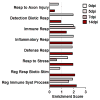Gene expression profiling studies in regenerating nerves in a mouse model for CMT1X: uninjured Cx32-knockout peripheral nerves display expression profile of injured wild type nerves
- PMID: 25447941
- PMCID: PMC4262134
- DOI: 10.1016/j.expneurol.2014.10.014
Gene expression profiling studies in regenerating nerves in a mouse model for CMT1X: uninjured Cx32-knockout peripheral nerves display expression profile of injured wild type nerves
Abstract
X-linked Charcot-Marie-Tooth disease (CMT1X) is an inherited peripheral neuropathy caused by mutations in GJB1, the human gene for Connexin32 (Cx32). This present study uses Ilumina Ref8-v2 BeadArray to examine the expression profiles of injured and uninjured sciatic nerves at 5, 7, and 14 days post-crush injury (dpi) from Wild Type (WT) and Cx32-knockout (Cx32KO) mice to identify the genes and signaling pathways that are dysregulated in the absence of Schwann cell Cx32. Given the assumption that loss of Schwann cell Cx32 disrupts the regeneration and maintenance of myelinated nerve leading to a demyelinating neuropathy in CMT1X, we initially hypothesized that nerve crush injury would result in significant increases in differential gene expression in Cx32KO mice relative to WT nerves. However, microarray analysis revealed a striking collapse in the number of differentially expressed genes at 5 and 7 dpi in Cx32KO nerves relative to WT, while uninjured and 14 dpi time points showed large numbers of differentially regulated genes. Further comparisons within each genotype showed limited changes in Cx32KO gene expression following crush injury when compared to uninjured Cx32KO nerves. By contrast, WT nerves exhibited robust changes in gene expression at 5 and 7 dpi with no significant differences in gene expression by 14dpi relative to uninjured WT nerve samples. Taken together, these data suggest that the gene expression profile in uninjured Cx32KO sciatic nerve strongly resembles that of a WT nerve following injury and that loss of Schwann cell Cx32 leads to a basal state of gene expression similar to that of an injured WT nerve. These findings support a role for Cx32 in non-myelinating and regenerating populations of Schwann cells in normal axonal maintenance in re-myelination, and regeneration of peripheral nerve following injury. Disruption of Schwann cell-axonal communication in CMT1X may cause dysregulation of signaling pathways that are essential for the maintenance of intact myelinated peripheral nerves and to establish the necessary conditions for successful regeneration and remyelination following nerve injury.
Keywords: CMT1X; Differential gene expression; Non-myelinating; Peripheral nerve injury; Regeneration; Schwann cells.
Copyright © 2014 Elsevier Inc. All rights reserved.
Figures








Similar articles
-
Effects of early crush on aging wild type and Connexin 32 knockout mice: Evidence for a neuroprotective state in CMT1X mouse nerve.J Peripher Nerv Syst. 2021 Jun;26(2):167-176. doi: 10.1111/jns.12436. Epub 2021 Mar 10. J Peripher Nerv Syst. 2021. PMID: 33624350
-
Intraneural GJB1 gene delivery improves nerve pathology in a model of X-linked Charcot-Marie-Tooth disease.Ann Neurol. 2015 Aug;78(2):303-16. doi: 10.1002/ana.24441. Epub 2015 Jun 30. Ann Neurol. 2015. PMID: 26010264
-
Intrathecal gene therapy in mouse models expressing CMT1X mutations.Hum Mol Genet. 2018 Apr 15;27(8):1460-1473. doi: 10.1093/hmg/ddy056. Hum Mol Genet. 2018. PMID: 29462293
-
Molecular genetics of X-linked Charcot-Marie-Tooth disease.Neuromolecular Med. 2006;8(1-2):107-22. doi: 10.1385/nmm:8:1-2:107. Neuromolecular Med. 2006. PMID: 16775370 Review.
-
Connexins, gap junctions and peripheral neuropathy.Neurosci Lett. 2015 Jun 2;596:27-32. doi: 10.1016/j.neulet.2014.10.033. Epub 2014 Oct 24. Neurosci Lett. 2015. PMID: 25449862 Review.
Cited by
-
Regulatory role of oligodendrocyte gap junctions in inflammatory demyelination.Glia. 2018 Dec;66(12):2589-2603. doi: 10.1002/glia.23513. Epub 2018 Oct 16. Glia. 2018. PMID: 30325069 Free PMC article.
-
What's the Function of Connexin 32 in the Peripheral Nervous System?Front Mol Neurosci. 2018 Jul 10;11:227. doi: 10.3389/fnmol.2018.00227. eCollection 2018. Front Mol Neurosci. 2018. PMID: 30042657 Free PMC article. Review.
References
-
- Abrams CK, Bennett MVL. Hereditary Human Diseases caused by connexin mutations. In: Peracchia C, editor. Gap Junctions- Molecular Basis of Cell Communication in Health and Disease. Academic Press; 2000.
-
- Abrams CK, Rash JE. Connexins in the Nervous System. In: Harris AL, Locke D, editors. Connexins: A Guide. Humana Press; 2009. pp. 323–358.
-
- Allodi I, Udina E, Navarro X. Specificity of peripheral nerve regeneration: Interactions at the axon level. Progress in neurobiology. 2012;98:16–37. - PubMed
Publication types
MeSH terms
Substances
Supplementary concepts
Grants and funding
LinkOut - more resources
Full Text Sources
Other Literature Sources
Medical
Molecular Biology Databases

